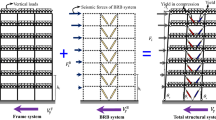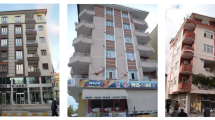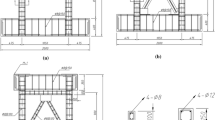Abstract
A satisfactory ductile performance of moment-resisting reinforced concrete concentric braced frame structures (RC-MRCBFs) is not warranted by only following the provisions proposed in Mexico’s Federal District Code (MFDC-04). The nonlinear behavior of low to medium rise ductile RC-MRCBFs using steel X-bracing susceptible to buckling is evaluated in this study. The height of the studied structures ranges from 4 to 20 stories and they were located for design in the lake-bed zone of Mexico City. The design of RC-MRCBFs was carried out considering variable contribution of the two main lines of defense of the dual system (RC columns and steel braces). In order to observe the principal elements responsible for dissipating the earthquake input energy, yielding mappings for different load-steps were obtained using both nonlinear static and dynamic analyses. Some design parameters currently proposed in MFDC-04 as global ductility capacities, overstrength reduction factors and story drifts corresponding to different limit states were assessed as a function of both the considered shear strength and slenderness ratios for the studied RC-MRCBFs using pushover analyses. Additionally, envelopes of response maxima of dynamic parameters were obtained from the story and global hysteresis curves. Finally, a brief discussion regarding residual drifts, residual drift ratios, mappings of residual deformations in steel braces and residual rotations in RC beams and columns is presented. From the analysis of the obtained results, it is concluded that when a suitable design criterion is considered, good structural behavior of RC-MRCBFs with steel-X bracing can be obtained. It is also observed that the shear strength balance has an impact in the height-wise distribution of residual drifts, and an important “shake-down” effect is obtained for all cases. There is a need to improve design parameters currently proposed in MFDC to promote an adequate seismic performance of RC-MRCBFs.
Similar content being viewed by others
References
Abou-Elfath H and Ghobarah A (2000), “Behaviour of Reinforced Concrete Frames Rehabilitated with Concentric Steel Bracing,” Canadian Journal of Civil Engineering, 27(3): 433–444.
Almeida A, Ferreira R, Proença JM and Gago AS (2017), “Seismic Retrofit of RC Building Structures with Buckling Restrained Braces,” Engineering Structures, 130(1): 14–22.
Aschheim M, Gülkan P, Sezen H, Bruneau M, Elnashai A, Halling M, Love J and Rahnama M (2000), “Kocaeli, Turkey, Earthquake of August 17, 1999: Reconnaissance report, Chapter 11 - Performance of Buildings,” Earthquake Spectra, 16(Supplement A): 237–279.
ASCE 7–10 (2010), Minimum Design Loads for Buildings and Other Structures, ASCE Standard ASCE/SEI 7–10, American Society of Civil Engineers, ISBN 978-0-7844-1085-1.
Aval BSB, Kouhestani HS and Mottaghi L (2017), “Effectiveness of Two Conventional Methods for Seismic Retrofit of Steel and RC Moment Resisting Frames Based on Damage Control Criteria,” Earthquake Engineering and Engineering Vibration, 16(3): 537–555. https://doi.org/10.1007/s11803-017-0404-y.
Badoux M and Jirsa J (1990), “Steel Bracing of RC Frames for Seismic Retrofitting,” ASCE Journal of Structural Engineering, 116(1): 55–74.
Barbagallo F, Bosco M, Marino EM, Rossi PP and Stramondo PR (2017), “A Multi-Performance Design Method for Seismic Upgrading of Existing RC Frames by BRBs,” Earthquake Engineering and Structural Dynamics, 46(7):1099–1119.
Black R, Wenger W and Popov E (1980), “Inelastic Buckling of Steel Struts under Cyclic Load Reversals,” Report No. UCB/EERC-80/40, Department of Civil Engineering, University of California at Berkeley.
Borja-Navarrete G, Díaz-Canales M, Vázquez-Vera A and Del Valle-Calderón E (1986), “Damage Statistics of the September 19, 1985 Earthquake in Mexico City,” Proceedings of International Workshop The Mexico City Earthquakes-1985, Factors Involved and Lessons Learned, ASCE, 70–77.
Bush T, Jones E and Jirsa J (1991), “Behavior of RC Frame Strengthened using Structural Steel Bracing,” ASCE Journal of Structural Engineering, 117(4): 1115–1126.
Carr AJ (2004), RUAUMOKO: Computer Program Library, Department of Civil Engineering, University of Canterbury, New Zealand.
Del Valle E (1980), “Some Lessons from the March 14, 1979 Earthquake in Mexico City,” Proceedings of 7th World Conference on Earthquake Engineering, Istanbul, Turkey, 4 (Part 1): 545–552.
D’Aniello M, La Manna Ambrosino G, Portioli F and Landolfo R (2015), “The Influence of Out-of-Straightness Imperfection in Physical Theory Models of Bracing Members on Seismic Performance Assessment of Concentric Braced Structures,” The Structural Design of Tall and Special Buildings, 24(3): 176–197.
Del Valle E, Foutch DA, Hjelmstad KD, Figueroa-Gutiérrez E and Tena-Colunga A (1988), “Seismic Retrofit of a RC Building: a Case Study,” Proceedings, 9th World Conference on Earthquake Engineering, Tokyo-Kyoto, Japan, VII: 451–456.
Della Corte G, D’Aniello M and Landolfo R (2015), “Field Testing of All-Steel Buckling Restrained Braces Applied to a Damaged Reinforced Concrete Building,” Journal of Structural Engineering, 141(1): D4014004.
Dicleli M and Calik EE (2008), “Physical Theory Hysteretic Model for Steel Braces,” Journal of Structural Engineering-ASCE, 134(7): 1215–1228.
Downs RE, Hjelmstad KD and Foutch DA (1991), “Evaluation of Two RC Buildings Retrofit with Steel Bracing,” Structural Research Series No. 563, Department of Civil Engineering, University of Illinois at Urbana-Champaign.
Elnashai AS and Mwafy AM (2002), “Overstrength and Force Reduction Factors of Multistorey Reinforced-Concrete Buildings,” The Structural Design of Tall Buildings, 11(5): 329–351.
El-Sokkary H and Galal K (2009), “Analytical Investigation of the Seismic Performance of RC Frames Rehabilitated Using Different Rehabilitation Techniques,” Engineering Structures, 31(9): 1955–1966.
Eskandari R, Vafaei D, Vafaei J and Shemshadian ME (2017), “Nonlinear Static and Dynamic Behavior of Reinforced Concrete Steel-Braced Frames,” Earthquakes and Structures, 12(2): 191–200.
Faella C, Lima C, Martinelli E and Realfonzo R (2014), “Steel Bracing Configurations for Seismic Retrofitting of a Reinforced Concrete Frame,” Proceedings of the Institution of Civil Engineers - Structures and Buildings, 167(1): 54–65.
Foutch DA, Hjelmstad KD, Del Valle E, Figueroa E and Downs RE (1989), “The Mexico Earthquake of September 19, 1985. Case Studies of Seismic Strengthening for Two Buildings in Mexico City,” Earthquake Spectra, 5(1): 153–174.
FEMA-273 (1997), NEHRP Guidelines for the Seismic Rehabilitation of Buildings, FEMA Publication 273, Washington, DC: Federal Emergency Management Agency, October.
FEMA-356 (2000), NEHRP Guidelines for the Seismic Rehabilitation of Buildings, FEMA Publication 356, Washington, DC: Federal Emergency Management Agency, November.
Farahi M and Mofid M (2013), “On the Quantification of Seismic Performance Factors of Chevron Knee Bracings, in Steel Structures,” Engineering Structures, 46(1): 155–164.
Ghaffarzadeh H and Maheri MR (2006), “Mechanical Compression Release Device in Steel Bracing System for Retrofitting RC Frames,” Earthquake Engineering and Engineering Vibration, 5(1): 151–158. https://doi.org/10.1007/s11803-006-0626-x
Ghobarah A and Abou-Elfath H (2001), “Rehabilitation of a Reinforced Concrete Frame Using Eccentric Steel Bracing,” Engineering Structures, 23: 745–755.
Godínez-Domínguez EA and Tena-Colunga A (2010), “Nonlinear Behavior of Code-Designed Reinforced Concrete Concentric Braced Frames under Lateral Loading,” Engineering Structures, 32(4): 944–963.
Godínez-Domínguez EA, Tena-Colunga A and Pérez-Rocha LE (2012), “Case Studies on the Seismic Behavior of Reinforced Concrete Chevron Braced Framed Buildings,” Engineering Structures, 45: 78–103.
Godínez-Domínguez EA and Tena-Colunga A (2016), “Redundancy Factors for the Seismic Design of Ductile Reinforced Concrete Chevron Braced Frames,” Latin American Journal of Solids and Structures, 13(11): 2088–2112.
Hartzell SH (1978), “Earthquake Aftershocks as Green’s Functions,” Geophysical Research Letters, 5: 1–4.
Henry RS, Sritharan S and Ingham JM (2016), “Residual Drift Analyses of Realistic Self-Centering Concrete Wall Systems,” Earthquakes and Structures, 10(2): 409–428.
Ikeda K, Mahin S and Dermitzakis S (1984), “Phenomenological Modeling of Steel Braces under Cyclic Loading,” Report No. UCB/EERC-84/09, Department of Civil Engineering, University of California at Berkeley.
Ikeda K and Mahin S (1984), “A Refined Physical Theory for Predicting the Seismic Behavior of Braced Steel Frames,” Report No. UCB/EERC-84/12, Department of Civil Engineering, University of California at Berkeley.
Ju M, Lee KS, Sim J and Kwon H (2014), “Non-Compression X-Bracing System Using CF Anchors for Seismic Strengthening of RC Structures,” Magazine of Concrete Research, 66(4): 159–174.
Kappos AJ (1999), “Evaluation of Behaviour Factors on the Basis of Ductility and Overstrength Studies,” Engineering Structures, 21(9): 823–835.
Kadid A and Yahiaoui D (2011), “Seismic Assessment of Braced RC Frames,” Procedia Engineering: The Proceedings of the Twelfth East Asia-Pacific Conference on Structural Engineering and Construction, 14: 2899–2905.
Kawamata S and Ohnuma M (1980), “Strengthening Effect of Eccentric Steel Braces to Existing Reinforced Concrete Frames,” Proceedings, 7th World Conference on Earthquake Engineering, Istanbul, Turkey.
Khatib I, Mahin S and Pister K (1988), “Seismic Behavior of Concentrically Braced Steel Frames,” Report No. UCB/EERC-88/01, Earthquake Engineering Research Center, University of California at Berkeley.
Khampanit A, Leelataviwat S, Kochanin J and Warnitchai P (2014), “Energy-Based Seismic Strengthening Design of Non-Ductile Reinforced Concrete Frames Using Buckling-Restrained Braces,” Engineering Structures, 81: 110–122.
Kemp RA (1996), “Inelastic Local and Lateral Buckling in Design Codes,” ASCE Journal of Structural Engineering, 122(4): 374–382.
Liu F, Wang L and Lu X (2012), “Experimental Investigations on the Seismic Performance of Un-Retrofitted and Retrofitted RC Frames,” Proceedings, 15th World Conference on Earthquake Engineering, Lisbon, Portugal.
Maheri MR and Sahebi A (1997), “Use of Steel Bracing in Reinforced Concrete Frames,” Engineering Structures, 19(12): 1018–1024.
Maheri MR and Akbari R (2003), “Seismic Behaviour Factor, R, for Steel X-Braced and Knee-Braced RC Buildings,” Engineering Structures, 25(12): 1505–1513.
Maheri MR, Kousari R and Razazan M (2003), “Pushover Tests on Steel X-Braced and Knee-Braced RC Frames,” Engineering Structures, 25(13): 1697–1705.
Maheri MR and Hadjipour A (2003), “Experimental Investigation and Design of Steel Brace Connection to RC Frame,” Engineering Structures, 25(13): 1707–1714.
Maheri MR and Ghaffarzadeh H (2008), “Connection Overstrength in Steel-Braced RC Frames,” Engineering Structures, 30(7): 1938–1948.
Maheri MR and Yazdani S (2016), “Design of Steel Brace Connection to an RC Frame Using Uniform Force Method,” Journal of Constructional Steel Research, 116: 131–140.
Martínez-Romero E (1993), “Experiences on the Use of Supplementary Energy Dissipators on Building Structures,” Earthquake Spectra, 9(3): 581–626.
Masri A and Goel S (1996), “Seismic Design and Testing of an RC Slab-Column Frame Strengthened by Steel Bracing,” Earthquake Spectra, 12(4): 645–666.
Newmark NM and Hall WJ (1982), Earthquake Spectra and Design, Monograph series, Earthquake Engineering Research Institute, Oakland.
Mitchell D and Paultre P (1994), “Ductility and Overstrength in Seismic Design of Reinforced Concrete Structures,” Canadian Journal of Civil Engineering, 21(6): 1049–1060.
MOC-15 (2015), Manual de diseño de obras civiles, diseño por sismo, Comisión Federal de Electricidad, México. (in Spanish)
Nateghi-A F (1995), “Seismic Strengthening of Eight-Storey RC Apartment Building Using Steel Braces,” Engineering Structures, 17(6): 455–461.
MFDC-04 (2004), Reglamento de Construcciones para el Distrito Federa, Gaceta Oficial del Departamento del Distrito Federal. (in Spanish)
NTCC-2004 (2004), Normas Técnicas Complementarias para Diseño y Construcción de Estructuras de Concreto, Gaceta Oficial del Distrito Federal, October. (in Spanish)
NTCS-2004 (2004), Normas Técnicas Complementarias para Diseño por Sismo, Gaceta Oficial del Distrito Federal, Tomo II, No. 103-BIS, 55–77, October. (in Spanish)
Osman A, Rashed A and El-Kady M (2006), “Seismic Response of RC Frames with Concentric Steel Bracing,” Proceedings, 8th National Conference on Earthquake Engineering, San Francisco, California, CDROM, Paper No. 1979.
Park R, Priestley MJN and Gill WD (1982), “Ductility of Square-Confined Concrete Columns,” ASCE Journal of Structural Engineering, 108(4): 929–950.
Pérez-Rocha LE (1998), “Respuesta Sísmica Estructural: Efectos de Sitio e Interacción Suelo-Estructura (Aplicaciones al Valle de México),” PhD Thesis, División de Estudios de Posgrado de la Facultad de Ingeniería, Universidad Nacional Autónoma de México. (in Spanish)
Qiao S, Han X and Zhou K (2017), “Bracing Configuration and Seismic Performance of Reinforced Concrete Frame with Brace,” The Structural Design of Tall and Special Buildings, 26(e1381): 1–14.
Qu Z, Xie J, Wang T and Kishiki S (2017), “Cyclic Loading Test of Double K-Braced Reinforce Concrete Frame Subassemblies with Buckling Restrained Braces,” Engineering Structures, 139(15):1–14.
Remennikov AM and Walpole WR (1995), “Incremental Model for Predicting the Inelastic Hysteretic Behaviour of Steel Bracing Members,” Research Report 956, Department of Civil Engineering, University of Canterbury, Christchurch, New Zealand.
Remennikov A and Walpole W (1997a), “Modelling the Inelastic Cyclic Behaviour of a Bracing Member for Work-Hardening Material,” International Journal of Solids and Structures, 34(27): 3491–3515.
Remennikov A and Walpole W (1997b), “Analytical Prediction of Seismic Behaviour for Concentrically-Braced Steel Systems,” Earthquake Engineering and Structural Dynamics, 26(8): 859–874.
Ruiz J and Miranda E (2006), “Evaluation of Residual Drift Demands in Regular Multi-Storey Frames for Performance-Based Seismic Assessment,” Earthquake Engineering and Structural Dynamics, 35(13): 1609–1629.
Saiidi M and Sozen MA (1979), “Simple and Complex Models for Nonlinear Seismic Response of Reinforced Concrete Structures,” Structural Research Series No. 465, Department of Civil Engineering, University of Illinois at Urbana-Champaign, August.
Sharmaa A, Eligehausen R and Reddya GR (2011), “A New Model to Simulate Joint Shear Behavior of Poorly Detailed Beam-Column Connections in RC Structures under Seismic Loads, Part I: Exterior Joints,” Engineering Structures, 33: 1034–1051.
Tagawa Y, Aoki H, Huang T and Masuda H (1992), “Experimental Study of New Seismic Strengthening Method for Existing RC Structure,” Proceedings, Tenth World Conference on Earthquake Engineering, Rotterdam, 5193–5198.
Tapia-Hernández E and Tena-Colunga A (2014), “Code-Oriented Methodology for the Seismic Design of Regular Steel Moment Resisting Braced Frames,” Earthquake Spectra, 30(4): 1683–1709.
Tena-Colunga A, Del Valle E and Pérez-Moreno D (1996), “Issues on the Seismic Retrofit of a Building Near Resonant Response and Structural Pounding,” Earthquake Spectra, 12(3): 567–597.
Tena-Colunga A (1999), “International Seismic Zone Tabulation Proposed by the 1997 UBC Code: Observations for Mexico,” Earthquake Spectra, 15(2): 331–360.
Tena-Colunga A (2007), “State of the Art and State of the Practice for Energy Dissipation and Seismic Isolation of Structures in Mexico,” Proceedings, 10th World Conference on Seismic Isolation, Energy Dissipation and Active Vibration Control of Structures, Istanbul, Turkey, CD-ROM.
Tena-Colunga A, Godínez-Domínguez EA and Pérez-Rocha LE (2007), “Vulnerability Maps for Reinforced Concrete Structures for Mexico City’s Metropolitan Area under a Design Earthquake Scenario,” Earthquake Spectra, 23(4): 809–840.
Tena-Colunga A, Correa-Arizmendi H, Luna-Arroyo JL and Gatica-Avilés G (2008), “Seismic Behavior of Code-Designed Medium Rise Special Moment-Resisting Frame RC Buildings in Soft Soils of Mexico City,” Engineering Structures, 30(12): 3681–3707.
Tena-Colunga A, Mena-Hernández U, Pérez-Rocha LE, Avilés J, Ordaz M and Vilar JI (2009), “Updated Seismic Design Guidelines for Buildings of a Model Code of Mexico,” Earthquake Spectra, 25 (4): 869–898.
Tena-Colunga A and Cortés-Benítez JA (2015), “Assessment of Redundancy Factors for the Seismic Design of Special Moment Resisting Reinforced Concrete Frames,” Latin American Journal of Solids and Structures, 12(12): 2330–2350.
Tena-Colunga A and Nangullasmú-Hernández HJ (2015), “Assessment of Seismic Design Parameters of Moment Resisting RC Braced Frames with Metallic Fuses,” Engineering Structures, 95: 138–153.
Tena-Colunga A and Hernández-Ramírez H (2017), “Code-Oriented Global Design Parameters for Moment-Resisting Steel Frames with Metallic Structural Fuses,” Frontiers in Built Environment, 3(19): 1–16.
Tong GS, Luo GF and Zhang L (2012), “Lateral Resistance of Moment Resisting-Chevron Braced Frames with Weak Beams,” Harbin Gongye Daxue Xuebao/Journal of Harbin Institute of Technology, 44(10): 128–134.
Uriz P, Filippou FC and Mahin SA (2008), “Model for Cyclic Inelastic Buckling of Steel Braces,” Journal of Structural Engineering-ASCE, 134(4): 619–628.
Vona M and Mastroberti M (2018), “Estimation of the Behavior Factor of Existing RC-MRF Buildings,” Earthquake Engineering and Engineering Vibration, 17(1): 191–204. https://doi.org/10.1007/s11803-018-0434-0
Xiao J, Li J and Chen J (2011), “Experimental Study on the Seismic Response of Braced Reinforced Concrete Frame with Irregular Columns,” Earthquake Engineering and Engineering Vibration, 10(4): 487–494. https://doi.org/10.1007/s11803-011-0083-z.
Youssef MA, Ghaffarzadeh H and Nehdi M (2007), “Seismic Performance of RC Frames with Concentric Internal Steel Bracing,” Engineering Structures, 29(7): 1561–1568.
Zhang L, Luo GF and Tong GS (2013), “Refined Study on Lateral-Force Resistance of Dual Structural System Composed of Moment-Resisting Frame and Chevron Braces,” Journal of Zhejiang University (Engineering Science), 47(10): 1815–1823.
Acknowledgment
The support granted to the first author by the National Science and Technology Council of Mexico (Conacyt) is gratefully acknowledged.
Author information
Authors and Affiliations
Corresponding author
Rights and permissions
About this article
Cite this article
Godínez-Domínguez, E.A., Tena-Colunga, A. Behavior of ductile steel X-braced RC frames in seismic zones. Earthq. Eng. Eng. Vib. 18, 845–869 (2019). https://doi.org/10.1007/s11803-019-0539-0
Received:
Accepted:
Published:
Issue Date:
DOI: https://doi.org/10.1007/s11803-019-0539-0




